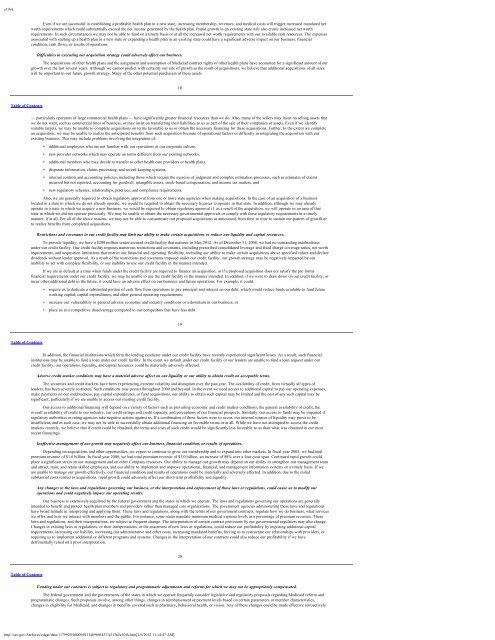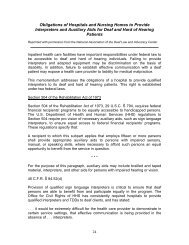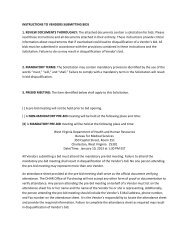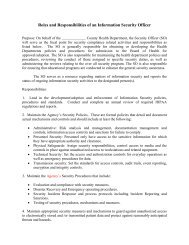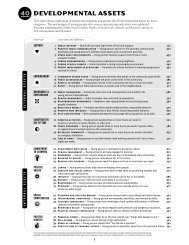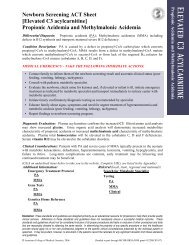Molina Medicaid Solutions - DHHR
Molina Medicaid Solutions - DHHR
Molina Medicaid Solutions - DHHR
You also want an ePaper? Increase the reach of your titles
YUMPU automatically turns print PDFs into web optimized ePapers that Google loves.
e10vkEven if we are successful in establishing a profitable health plan in a new state, increasing membership, revenues, and medical costs will trigger increased mandated networth requirements which could substantially exceed the net income generated by the health plan. Rapid growth in an existing state will also create increased net worthrequirements. In such circumstances we may not be able to fund on a timely basis or at all the increased net worth requirements with our available cash resources. The expensesassociated with starting up a health plan in a new state or expanding a health plan in an existing state could have a significant adverse impact on our business, financialcondition, cash flows, or results of operations.Difficulties in executing our acquisition strategy could adversely affect our business.The acquisitions of other health plans and the assignment and assumption of <strong>Medicaid</strong> contract rights of other health plans have accounted for a significant amount of ourgrowth over the last several years. Although we cannot predict with certainty our rate of growth as the result of acquisitions, we believe that additional acquisitions of all sizeswill be important to our future growth strategy. Many of the other potential purchasers of these assets18Table of Contents— particularly operators of large commercial health plans — have significantly greater financial resources than we do. Also, many of the sellers may insist on selling assets thatwe do not want, such as commercial lines of business, or may insist on transferring their liabilities to us as part of the sale of their companies or assets. Even if we identifysuitable targets, we may be unable to complete acquisitions on terms favorable to us or obtain the necessary financing for these acquisitions. Further, to the extent we completean acquisition, we may be unable to realize the anticipated benefits from such acquisition because of operational factors or difficulty in integrating the acquisition with ourexisting business. This may include problems involving the integration of:• additional employees who are not familiar with our operations or our corporate culture,• new provider networks which may operate on terms different from our existing networks,• additional members who may decide to transfer to other health care providers or health plans,• disparate information, claims processing, and record keeping systems,• internal controls and accounting policies, including those which require the exercise of judgment and complex estimation processes, such as estimates of claimsincurred but not reported, accounting for goodwill, intangible assets, stock-based compensation, and income tax matters, and• new regulatory schemes, relationships, practices, and compliance requirements.Also, we are generally required to obtain regulatory approval from one or more state agencies when making acquisitions. In the case of an acquisition of a businesslocated in a state in which we do not already operate, we would be required to obtain the necessary licenses to operate in that state. In addition, although we may alreadyoperate in a state in which we acquire a new business, we would be required to obtain regulatory approval if, as a result of the acquisition, we will operate in an area of thatstate in which we did not operate previously. We may be unable to obtain the necessary governmental approvals or comply with these regulatory requirements in a timelymanner, if at all. For all of the above reasons, we may not be able to consummate our proposed acquisitions as announced from time to time to sustain our pattern of growth orto realize benefits from completed acquisitions.Restrictions and covenants in our credit facility may limit our ability to make certain acquisitions or reduce our liquidity and capital resources.To provide liquidity, we have a $200 million senior secured credit facility that matures in May 2012. As of December 31, 2008, we had no outstanding indebtednessunder our credit facility. Our credit facility imposes numerous restrictions and covenants, including prescribed consolidated leverage and fixed charge coverage ratios, net worthrequirements, and acquisition limitations that restrict our financial and operating flexibility, including our ability to make certain acquisitions above specified values and declaredividends without lender approval. As a result of the restrictions and covenants imposed under our credit facility, our growth strategy may be negatively impacted by ourinability to act with complete flexibility, or our inability to use our credit facility in the manner intended.If we are in default at a time when funds under the credit facility are required to finance an acquisition, or if a proposed acquisition does not satisfy the pro formafinancial requirements under our credit facility, we may be unable to use the credit facility in the manner intended. In addition, if we were to draw down on our credit facility, orincur other additional debt in the future, it could have an adverse effect on our business and future operations. For example, it could:• require us to dedicate a substantial portion of cash flow from operations to pay principal and interest on our debt, which would reduce funds available to fund futureworking capital, capital expenditures, and other general operating requirements;• increase our vulnerability to general adverse economic and industry conditions or a downturn in our business; or• place us at a competitive disadvantage compared to our competitors that have less debt.19Table of ContentsIn addition, the financial institutions which form the lending syndicate under our credit facility have recently experienced significant losses. As a result, such financialinstitutions may be unable to fund a loan under our credit facility. In the event we default under our credit facility or our lenders are unable to fund a loan request under ourcredit facility, our operations, liquidity, and capital resources could be materially adversely affected.Adverse credit market conditions may have a material adverse affect on our liquidity or our ability to obtain credit on acceptable terms.The securities and credit markets have been experiencing extreme volatility and disruption over the past year. The availability of credit, from virtually all types oflenders, has been severely restricted. Such conditions may persist throughout 2009 and beyond. In the event we need access to additional capital to pay our operating expenses,make payments on our indebtedness, pay capital expenditures, or fund acquisitions, our ability to obtain such capital may be limited and the cost of any such capital may besignificant, particularly if we are unable to access our existing credit facility.Our access to additional financing will depend on a variety of factors such as prevailing economic and credit market conditions, the general availability of credit, theoverall availability of credit to our industry, our credit ratings and credit capacity, and perceptions of our financial prospects. Similarly, our access to funds may be impaired ifregulatory authorities or rating agencies take negative actions against us. If a combination of these factors were to occur, our internal sources of liquidity may prove to beinsufficient, and in such case, we may not be able to successfully obtain additional financing on favorable terms or at all. While we have not attempted to access the creditmarkets recently, we believe that if credit could be obtained, the terms and costs of such credit would be significantly less favorable to us than what was obtained in our mostrecent financings.Ineffective management of our growth may negatively affect our business, financial condition, or results of operations.Depending on acquisitions and other opportunities, we expect to continue to grow our membership and to expand into other markets. In fiscal year 2005, we had totalpremium revenue of $1.6 billion. In fiscal year 2008, we had total premium revenue of $3.0 billion, an increase of 88% over a four-year span. Continued rapid growth couldplace a significant strain on our management and on other Company resources. Our ability to manage our growth may depend on our ability to strengthen our management teamand attract, train, and retain skilled employees, and our ability to implement and improve operational, financial, and management information systems on a timely basis. If weare unable to manage our growth effectively, our financial condition and results of operations could be materially and adversely affected. In addition, due to the initialsubstantial costs related to acquisitions, rapid growth could adversely affect our short-term profitability and liquidity.Any changes to the laws and regulations governing our business, or the interpretation and enforcement of those laws or regulations, could cause us to modify ouroperations and could negatively impact our operating results.Our business is extensively regulated by the federal government and the states in which we operate. The laws and regulations governing our operations are generallyintended to benefit and protect health plan members and providers rather than managed care organizations. The government agencies administering these laws and regulationshave broad latitude in interpreting and applying them. These laws and regulations, along with the terms of our government contracts, regulate how we do business, what serviceswe offer, and how we interact with members and the public. For instance, some states mandate minimum medical expense levels as a percentage of premium revenues. Theselaws and regulations, and their interpretations, are subject to frequent change. The interpretation of certain contract provisions by our governmental regulators may also change.Changes in existing laws or regulations, or their interpretations, or the enactment of new laws or regulations, could reduce our profitability by imposing additional capitalrequirements, increasing our liability, increasing our administrative and other costs, increasing mandated benefits, forcing us to restructure our relationships with providers, orrequiring us to implement additional or different programs and systems. Changes in the interpretation of our contracts could also reduce our profitability if we havedetrimentally relied on a prior interpretation.20Table of ContentsFunding under our contracts is subject to regulatory and programmatic adjustments and reforms for which we may not be appropriately compensated.The federal government and the governments of the states in which we operate frequently consider legislative and regulatory proposals regarding <strong>Medicaid</strong> reform andprogrammatic changes. Such proposals involve, among other things, changes in reimbursement or payment levels based on certain parameters or member characteristics,changes in eligibility for <strong>Medicaid</strong>, and changes in benefits covered such as pharmacy, behavioral health, or vision. Any of these changes could be made effective retroactively.http://sec.gov/Archives/edgar/data/1179929/000095013409005437/a51362e10vk.htm[1/6/2012 11:14:47 AM]


